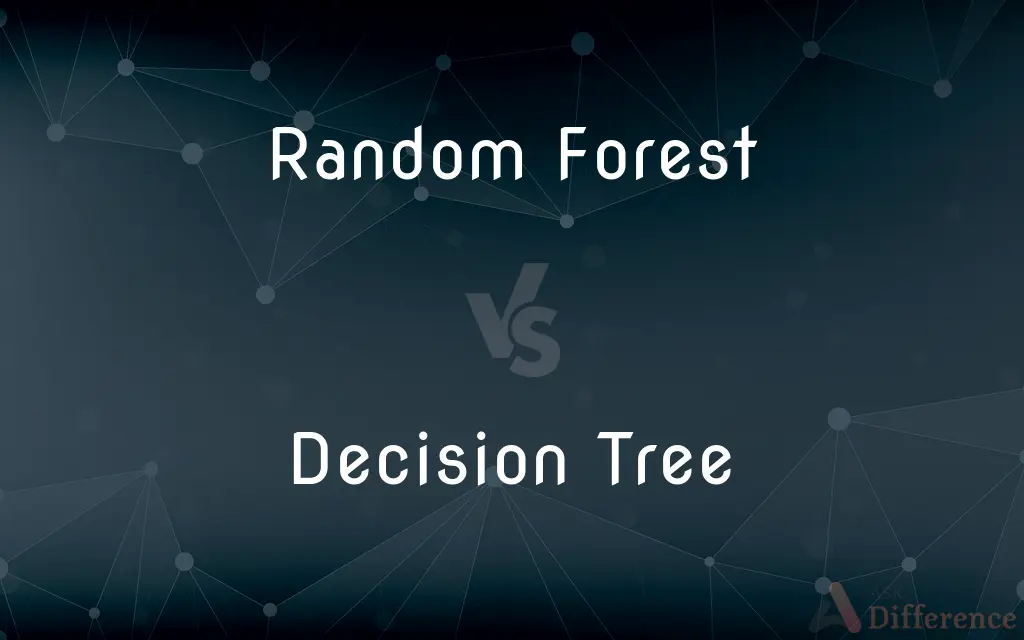Random Forest vs. Decision Tree — What's the Difference?
By Tayyaba Rehman — Published on January 15, 2024
A Decision Tree is a single tree-like model used for classification or regression, making decisions based on rules. A Random Forest is an ensemble of multiple decision trees, working together to improve accuracy and reduce overfitting.

Difference Between Random Forest and Decision Tree
Table of Contents
ADVERTISEMENT
Key Differences
A Decision Tree is a singular model that splits data based on certain conditions or rules, resembling a tree with branches leading to outcomes or decisions. Random Forest, in contrast, consists of multiple decision trees, each constructed using a random subset of data and features, to create a 'forest'.
Decision Trees are simple to understand and interpret, making them useful for gaining insights into data. Random Forests are more complex due to the aggregation of multiple trees but provide more accurate predictions and are better at handling overfitting.
In a Decision Tree, each decision point splits the data based on the best feature, which can lead to overfitting on the training data. Random Forests reduce overfitting by averaging the results of various trees, each trained on different parts of the data.
Decision Trees can be sensitive to small changes in the data, potentially leading to different structures. Random Forests are more stable, as the collective decision-making of multiple trees minimizes the impact of variations in the data.
Training a Decision Tree is generally faster and requires less computational resources than a Random Forest, which needs to train multiple trees. However, the trade-off is that Random Forests often deliver superior performance, especially in complex datasets.
ADVERTISEMENT
Comparison Chart
Model Structure
Ensemble of multiple decision trees.
Single tree-like model.
Overfitting
Less prone due to averaging of multiple trees.
More prone to overfitting on training data.
Accuracy
Generally higher due to ensemble approach.
Can vary; sometimes less accurate.
Interpretability
More complex, harder to interpret.
Simple and easy to understand.
Stability
More stable against variations in data.
Sensitive to small changes in data.
Compare with Definitions
Random Forest
Combines predictions from various trees to improve result reliability.
Using Random Forest reduced overfitting compared to a single Decision Tree.
Decision Tree
Efficient for smaller datasets and simpler problems.
For the small dataset, a single Decision Tree was sufficient and effective.
Random Forest
Each tree in a Random Forest is built from a random sample of data.
The diversity of trees in the Random Forest ensures robust predictions.
Decision Tree
Splits data into branches based on feature values to reach a decision.
Our Decision Tree split customers based on age and purchasing habits.
Random Forest
Balances bias and variance, making it suitable for various datasets.
We chose Random Forest for its strong performance across different datasets.
Decision Tree
Decision Tree is a flowchart-like tree structure for making predictions.
The Decision Tree model clearly showed the decision rules for classification.
Random Forest
Random Forest is an ensemble learning method using multiple decision trees.
The Random Forest model improved accuracy in our classification task.
Decision Tree
Prone to overfitting if not properly pruned or limited in depth.
We limited the depth of the Decision Tree to prevent overfitting.
Random Forest
Widely used in complex tasks for its high accuracy and versatility.
Random Forest was effective in predicting customer behavior patterns.
Decision Tree
Simple to interpret, making it useful for understanding data features.
The Decision Tree helped visualize how different factors affected sales.
Common Curiosities
Can Decision Trees handle both classification and regression?
Yes, they can be used for both types of tasks.
Why does Random Forest reduce overfitting?
Averaging multiple trees reduces the impact of noise and outliers.
Is Random Forest better than a single Decision Tree?
Often, yes, due to improved accuracy and less overfitting.
Are Random Forests used in real-world applications?
Yes, extensively in areas like finance, healthcare, and e-commerce.
Are Random Forests easy to interpret?
They are less interpretable than single trees due to their complexity.
How does a Decision Tree handle continuous data?
It splits continuous data at points that best separate the target variable.
How many trees are typically in a Random Forest?
It varies, often ranging from tens to hundreds.
Is feature selection important for Decision Trees?
Yes, choosing relevant features can improve tree performance.
Is training time longer for Random Forest compared to Decision Tree?
Yes, as it involves building multiple trees.
Are there any downsides to using Random Forest?
Mainly its complexity and computational cost.
Can a Decision Tree handle large datasets effectively?
It can, but may become complex and overfit.
Can a Decision Tree deal with missing data?
It can, but often requires preprocessing to handle missing values effectively.
Does the size of the Decision Tree affect its performance?
Yes, larger trees can become overfit and complex.
Can Random Forest handle categorical data?
Yes, it handles categorical data well.
How does Random Forest perform feature selection?
It inherently performs feature selection by choosing the best split.
Share Your Discovery

Previous Comparison
Ceramic Capacitor vs. Electrolytic Capacitor
Next Comparison
Fusion 360 vs. BlenderAuthor Spotlight
Written by
Tayyaba RehmanTayyaba Rehman is a distinguished writer, currently serving as a primary contributor to askdifference.com. As a researcher in semantics and etymology, Tayyaba's passion for the complexity of languages and their distinctions has found a perfect home on the platform. Tayyaba delves into the intricacies of language, distinguishing between commonly confused words and phrases, thereby providing clarity for readers worldwide.
















































